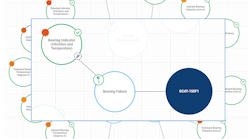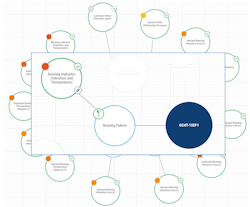Editor's Note: This post was sponsored by Itus Digital.
Modern asset performance management (APM) combines traditional asset management practices with new digital technologies for transformation advances in reliability, maintenance execution, and business performance. However, many plant teams wrestle with large asset ecosystems and the dozens of tools available to manage machine health. Factor in tools like machine learning and artificial intelligence, and it’s no wonder that APM strategies can get bogged down.
We recently caught up with Joe Nichols, Co-Founder and President at Itus Digital, for a conversation on how plant teams can navigate the overwhelming variety of approaches to asset management, and implement an APM strategy that is effective at their facility. Before forming Itus Digital, Joe was the COO & VP of Product Strategy at GE Digital and also held executive positions at Meridium.
Joe Nichols, Co-Founder and President, Itus Digital
Q: Joe, for those who might not be familiar with you or Itus Digital, can you tell us about the company?
A: Itus Digital has some of the most experienced individuals from the Asset Performance Management solution space. Many of our team members spent over 20 years with Meridium, later acquired by GE, delivering enterprise solutions to minimize equipment failure rates and optimize maintenance strategies. Our collective experience working with asset operators, deploying monitoring and diagnostic centers with OEM’s, and enabling service providers drives a unique perspective on the use cases and technical approaches to ensure optimal asset performance.
Q: Asset performance management has become an elastic term, stretching to fit the wide number of approaches that industry takes to asset care. What does that term mean to you, and to Itus Digital as an organization?
A: Yes, “elastic” is a great way to describe all the different methodologies and technical approaches for “Asset Performance Management.” The industrial market has significant variability in organizational size and maturity, manufacturing processes, equipment complexity, and potential return on investment, and we may actually be doing a disservice by attempting to create a one-size-fits-all definition for Asset Performance Management.
However, there are some common characteristics that we generally see in APM initiatives regardless of the broader variables. One of the key organizational characteristics is having aligned motivation and metrics to improve equipment availability. Unfortunately, we still see a lot of friction between operations looking to get product out at all costs and maintenance looking to preserve equipment life as long as possible. However when they both get on the same page with the long view of high availability, great things can happen!
Another key element we see in APM programs is the use of risk-based and proactive methodologies with a specific intent on focusing resources in high impact areas and reducing reactive activities as much as possible. While industry has generally understood that reactive work can be 4-10x the cost of proactive maintenance, the recent challenges in industrial staffing and supply chains have pushed more companies to assess failure risk more deeply, target resources more effectively, drive more preventative maintenance, and institute techniques to establish advanced warning of potential failure.
Finally, we see APM as a defined business process that engages all the appropriate equipment stakeholders and ensures the execution of a continuous improvement loop. Back to the functional silos mentioned earlier, improving asset performance takes a village and a structured sequence of repeatable steps to ensure continuous optimization; this is a key characteristic for any successful APM initiative.
Figure 1. Operationalized Asset Strategy.
Q: Companies have embraced APM as a conceptual approach but can struggle with implementation because it can be difficult to capture the value. What are some of the observations you have made over the years when these programs fall apart?
A: First let’s discuss some of the good news: most organizations are now establishing good foundations for asset management. Standards such as ISO 55000 have established meaningful blueprints for definitions, data structures and work process that companies can leverage to speed asset management programs. Many organizations now have core business systems to tracks assets, coordinate maintenance resources, and monitor manufacturing processes. Technically, we now have more data available to us about the equipment and process than ever, in fact there are many teams and organizations out there now that struggle to contextualize all of the raw data available to them.
Here is the bad news: traditional methods to implement APM have focused on top-down or enterprise models that attempt to solve for every reliability methodology on every asset. This approach tends to be expensive, complex, difficult to use and may never reach the projected benefit. It also quickly exposes pre-existing organizational challenges such as limited resources or differing perspectives on the “right” approach which can limit value creation.
Which assets should we focus on and why? Should we focus on a specific PdM technique? How about a fancy machine learning algorithm for anomaly detection, will that solve all my reliability problems? We could just focus on RCAs and learn from mistakes, that’s all we need to do right? Unfortunately, the answers to these questions could be different for everyone and, in our opinion, this is why so many of these initiatives fail to reach their true potential.
Q: Itus was founded to help companies streamline their APM efforts. Can you tell us about that founding impulse, and where the focus of the company is today?
A: In short, we saw an opportunity to meet industrial companies where they are. We also saw an opportunity to remove complexity and allow organizations of any size and maturity the ability to capture the value of improved asset performance. When we evaluate the successful organizations we worked with over the last 20 years we identified a common thread – a maniacal focus on the lifecycle management of asset strategies.
An asset strategy is a documented understanding for how an asset can potentially fail, the risk that the asset presents to the business, and an economically justified plan to mitigate that risk. So, we created a seamless process to define, manage, and operationalize asset strategies. Many organizations already have elements of asset strategies in place, maybe some FMEA work has been done, some form of Preventative Maintenance is being performed, PdM programs are established for critical assets, etc.
However, most organizations have not fully operationalized their asset strategies – the have not established standardized best practices across equipment classes. They struggle to get their PM’s fully implemented or even know if the PM’s are being done per the plan. Most importantly these strategies are not ‘living’ or operationalized, so they don’t get adjusted when equipment wears, maintenance is skipped, operating conditions change, or the macro business environment requires a shift in throughput or spend. Industrial environments are very dynamic, the strategies to manage those assets must be able to flex as well with robust tools to manage that lifecycle.
Our other focus was creating a business model that removes the significant upfront cost and risk of implementing an APM solution. Our customers scale and manage their investment based upon their requirements, budgets, and value targets through a simple, per asset, pay as you go model. This approach empowers an organization to optimize asset strategies for whatever is important to them, on their terms, and ensure investment never scales past ROI hurdle rates.
That’s our focus – simple, effective management of an asset strategy and a business model that scales directly with the customer needs.
This story originally appeared in the September 2022 issue of Plant Services. Subscribe to Plant Services here.


